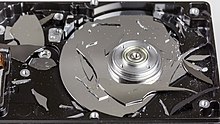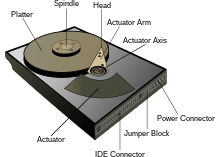Hard disk drive
Hard disk drive
Hard disk drive: A hard disk drive (HDD), hard disk, hard drive, or fixed disk[b] is an electromechanical data storage device that uses magnetic storage to store and retrieve digital information using one or more rigid rapidly rotating disks (platters) coated with magnetic material. The platters are paired with magnetic heads, usually arranged on a moving actuator arm, which read and write data to the platter surfaces.[2] Data is accessed in a random-access manner, meaning that individual blocks of data can be stored or retrieved in any order and not only sequentially. HDDs are a type of non-volatile storage, retaining stored data even when powered off.[3][4][5]
Introduced by IBM in 1956,[6] HDDs were the dominant secondary storage device for general-purpose computers beginning in the early 1960s. HDDs maintained this position in the modern era of servers and personal computers, though personal computing devices produced in large volumes, like cell phones and tablets, rely on flash products. More than 224 companies have produced HDDs historically, though after extensive industry consolidation most units are manufactured by Seagate, Toshiba, and Western Digital. HDDs dominate the volume of storage produced (exabytes per year) for servers. Though production is growing slowly, sales revenues and unit shipments are declining because solid-state drives (SSDs) have higher data-transfer rates, higher areal storage density, better reliability,[7] and much lower latency and access times.[8][9][10][11]
The revenues for SSDs, most of which use NAND, slightly exceed those for HDDs.[12] Flash storage products had more than twice the revenue of hard disk drives as of 2017.[13] Though SSDs have four to nine times higher cost per bit,[14][15] they are replacing HDDs in applications where speed, power consumption, small size, high capacity, and durability are important.[10][11] Cost per bit for SSDs is falling, and the price premium over HDDs has narrowed.[15]
The primary characteristics of an HDD are its capacity and performance. Capacity is specified in unit prefixes corresponding to powers of 1000: a 1-terabyte (TB) drive has a capacity of 1,000 gigabytes (GB; where 1 gigabyte = 1 billion bytes). Typically, some of an HDD's capacity is unavailable to the user because it is used by the file system and the computer operating system, and possibly inbuilt redundancy for error correction and recovery. Also, there is confusion regarding storage capacity since capacities are stated in decimal Gigabytes (powers of 10) by HDD manufacturers, whereas some operating systems report capacities in binary Gibibytes, which results in a smaller number than advertised. Performance is specified by the time required to move the heads to a track or cylinder (average access time) adding the time it takes for the desired sector to move under the head (average latency, which is a function of the physical rotational speed in revolutions per minute), and finally the speed at which the data is transmitted (data rate).
The two most common form factors for modern HDDs are 3.5-inch, for desktop computers, and 2.5-inch, primarily for laptops. HDDs are connected to systems by standard interface cables such as PATA (Parallel ATA), SATA (Serial ATA), USB or SAS (Serial Attached SCSI) cables.
History: The first production IBM hard disk drive, the 350 disk storage, shipped in 1957 as a component of the IBM 305 RAMAC system. It was approximately the size of two medium-sized refrigerators and stored five million six-bit characters (3.75 megabytes)[16] on a stack of 50 disks.[31]
In 1962, the IBM 350 was superseded by the IBM 1301 disk storage unit,[32] which consisted of 50 platters, each about 18-inch thick and 24 inches in diameter.[33] While the IBM 350 used only two reads/write heads,[31] 1301 used an array of heads, one per platter, moving as a single unit. Cylinder-mode read/write operations were supported, and the heads flew about 250 micro-inches (about 6 µm) above the platter surface. The motion of the head array depended upon a binary adder system of hydraulic actuators which assured repeatable positioning. The 1301 cabinet was about the size of three home refrigerators placed side by side, storing the equivalent of about 21 million eight-bit bytes. Access time was about a quarter of a second.
Also in 1962, IBM introduced the model 1311 disk drive, which was about the size of a washing machine and stored two million characters on a removable disk pack. Users could buy additional packs and interchange them as needed, much like reels of magnetic tape. Later models of removable pack drives, from IBM and others, became the norm in most computer installations and reached capacities of 300 megabytes by the early 1980s. Non-removable HDDs were called "fixed disk" drives.
Some high-performance HDDs were manufactured with one head per track, e.g., Burroughs B-475 in 1964, IBM 2305 in 1970, so that no time was lost physically moving the heads to a track and the only latency was the time for the desired block of data to rotate into position under the head.[34] Known as fixed-head or head-per-track disk drives, they were very expensive and are no longer in production.[35]
In 1973, IBM introduced a new type of HDD code-named "Winchester". Its primary distinguishing feature was that the disk heads were not withdrawn completely from the stack of disk platters when the drive was powered down. Instead, the heads were allowed to "land" on a special area of the disk surface upon spin-down, "taking off" again when the disk was later powered on. This greatly reduced the cost of the head actuator mechanism but precluded removing just the disks from the drive as was done with the disk packs of the day. Instead, the first models of "Winchester technology" drive featured a removable disk module, which included both the disk pack and the head assembly, leaving the actuator motor in the drive upon removal. Later "Winchester" drives abandoned the removable media concept and returned to non-removable platters.
Like the first removable pack drive, the first "Winchester" drives used platters 14 inches (360 mm) in diameter. A few years later, designers were exploring the possibility that physically smaller platters might offer advantages. Drives with non-removable eight-inch platters appeared and then drives that used a 51⁄4 in (130 mm) form factor (a mounting width equivalent to that used by contemporary floppy disk drives). The latter were primarily intended for the then-fledgling personal computer (PC) market.
As the 1980s began, HDDs were a rare and very expensive additional feature in PCs, but by the late 1980s, their cost had been reduced to the point where they were standard on all but the cheapest computers.
Most HDDs in the early 1980s were sold to PC end users as an external, add-on subsystem. The subsystem was not sold under the drive manufacturer's name but under the subsystem manufacturer's name such as Corvus Systems and Tallgrass Technologies, or under the PC system manufacturer's name such as the Apple ProFile. The IBM PC/XT in 1983 included an internal 10 MB HDD, and soon thereafter internal HDDs proliferated on personal computers.
External HDDs remained popular for much longer on the Apple Macintosh. Many Macintosh computers made between 1986 and 1998 featured a SCSI port on the back, making external expansion simple. Older compact Macintosh computers did not have user-accessible hard drive bays (indeed, the Macintosh 128K, Macintosh 512K, and Macintosh Plus did not feature a hard drive bay at all), so on those models, external SCSI disks were the only reasonable option for expanding upon any internal storage.
HDD improvements have been driven by increasing areal density, listed in the table above. Applications expanded through the 2000s, from the mainframe computers of the late 1950s to most mass storage applications including computers and consumer applications such as storage of entertainment content.
In the 2000s and 2010s, NAND began supplanting HDDs in applications requiring portability or high performance. NAND performance is improving faster than HDDs, and applications for HDDs are eroding. In 2018, the largest hard drive had a capacity of 15 TB, while the largest capacity SSD had a capacity of 100 TB.[36] As of 2018, HDDs were forecast to reach 100 TB capacities around 2025,[37] but as of 2019, the expected pace of improvement was pared back to 50 TB by 2026.[38] Smaller form factors, 1.8-inches and below, were discontinued around 2010. The cost of solid-state storage (NAND), represented by Moore's law, is improving faster than HDDs. NAND has a higher price elasticity of demand than HDDs, and this drives the market growth.[39] During the late 2000s and 2010s, the product life cycle of HDDs entered a mature phase, and slowing sales may indicate the onset of the declining phase
Technology: A modern HDD records data by magnetizing a thin film of ferromagnetic material[e] on both sides of a disk. Sequential changes in the direction of magnetization represent binary data bits. The data is read from the disk by detecting the transitions in magnetization. User data is encoded using an encoding scheme, such as run-length limited encoding,[f] which determines how the data is represented by the magnetic transitions.
A typical HDD design consists of a spindle that holds flat circular disks, called platters, which hold the recorded data. The platters are made from a non-magnetic material, usually aluminum alloy, glass, or ceramic. They are coated with a shallow layer of magnetic material typically 10–20 nm in-depth, with an outer layer of carbon for protection.[43][44][45] For reference, a standard piece of copy paper is 0.07–0.18 mm (70,000–180,000 nm)[46] thick.
The platters in contemporary HDDs are spun at speeds varying from 4,200 RPM in energy-efficient portable devices, to 15,000 rpm for high-performance servers.[48] The first HDDs spun at 1,200 rpm[6] and, for many years, 3,600 rpm was the norm.[49] As of November 2019, the platters in most consumer-grade HDDs spin at 5,400 or 7,200 RPM.
Information is written to and read from a platter as it rotates past devices called read-and-write heads that are positioned to operate very close to the magnetic surface, with their flying height often in the range of tens of nanometers. The read-and-write head is used to detect and modify the magnetization of the material passing immediately under it.
In modern drives, there is one head for each magnetic platter surface on the spindle, mounted on a common arm. An actuator arm (or access arm) moves the heads on an arc (roughly radially) across the platters as they spin, allowing each head to access almost the entire surface of the platter as it spins. The arm is moved using a voice coil actuator or in some older designs a stepper motor. Early hard disk drives wrote data at some constant bits per second, resulting in all tracks having the same amount of data per track but modern drives (since the 1990s) use zone bit recording – increasing the write speed from inner to outer zone and thereby storing more data per track in the outer zones.
In modern drives, the small size of the magnetic regions creates the danger that their magnetic state might be lost because of thermal effects — thermally induced magnetic instability which is commonly known as the "superparamagnetic limit". To counter this, the platters are coated with two parallel magnetic layers, separated by a three-atom layer of the non-magnetic element ruthenium, and the two layers are magnetized in the opposite orientation, thus reinforcing each other.[50] Another technology used to overcome thermal effects to allow greater recording densities is perpendicular recording, first shipped in 2005,[51] and as of 2007 used in certain HDDs.[52][53][54]
In 2004, a higher-density recording media was introduced, consisting of coupled soft and hard magnetic layers. So-called exchange spring media magnetic storage technology, also known as exchange coupled composite media, allows good writability due to the write-assist nature of the soft layer. However, the thermal stability is determined only by the hardest layer and not influenced by the soft layer.











No comments